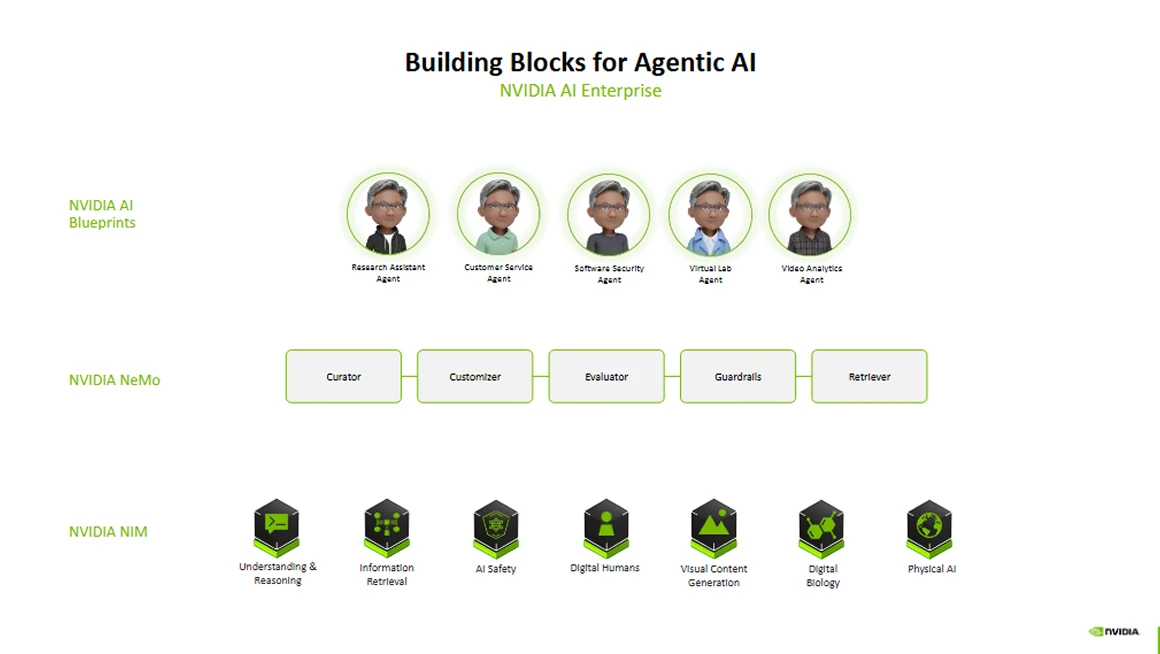Secure. Trainable. Private.
Discover the power and peace of mind that come with privately hosted AI models. Unlike public AI services, privately hosted AI models offer enhanced security and privacy, ensuring your data remains fully confidential and exclusively yours.
Privately hosted AI also empowers customization, allowing you to train models specifically suited to your unique data and business objectives - driving deeper insights, superior predictions, and greater competitive advantage.
What are Agents, Blueprints, NIMs, and CUDA frameworks?
An agent is the end product and what a user will interact with. Think of an avatar of a customer service bot.
The Blueprint represents the workflow for an application an agent to take inputs and process them in order to provide an output.
A NIM - NVIDIA Inferenced Microservice - is the discrete building block of a Blueprint. A NIM might convert speech to text. Another NIM would convert text to speech. These would form part of the workflow that makes up the Blueprint.
CUDA libraries are functions that interact with the GPU and enable data to be processed in parallel. They are used to interact with the hardware.
 Explore NVAIE
Explore NVAIE

Private RAG LLM
A private retrieval-augmented generation (RAG) LLM enhances data privacy and security by ensuring sensitive information stays within your own boundaries.
Our RAG LLMs provide context-specific responses by integrating proprietary data, significantly improving accuracy and relevance compared to general-purpose models.

PDF Extraction
Rapid retrieval of data from vast libraries of pdf documents to generate summaries, improve decision making and correct human errors.
Extract text, figures, and charts from documents to update databases and prepare meeting briefs. You can use this information to check for missing data, inform chatbots, and integrate with CRMs, ERPs, and HR systems.

Transcription & Note-taking
Transcribe audio, extract text from images and analyse context.
Save time sharing information by understanding meaning instead of just keywords, and automatically update apps and databases to kickstart agentic workflows.

File Analysis and Organisation
Rapidly categorise large numbers of files based on their content and create structured labels based on their data source.
Analyse video for important events, add captions and generate summaries. Search rapidly through hours of footage and identify subtle detail in the pictures. Extend search to images, with labelling and descriptions of fine details.

Virtual agents & avatars
Create a digital avatar as a virtual assistant trained on proprietary information to talk with customers about their precise requirements.
A highly engaging interface for customer support, training, virtual tours, and product demonstrations - perfect for those creating repeatable, engaging content.
Make your AI Model Private
Private Inferenced Microservices (PIMs) represent turnkey AI models that bring the best of both worlds - a model that has been trained on large datasets, which can then be applied to privately-owned or sensitive commercial data to get results
Start your PIMs, right-size the model and hosted environment to scale, and start making gains
FAQs
Agentic AI refers to artificial intelligence systems that act with agency, meaning they can autonomously make decisions, pursue goals, and adapt to new information without needing constant human input. Unlike traditional AI, which typically responds to prompts or follows fixed rules, Agentic AI plans, reasons about its environment, uses tools, and can self-correct over time.
Agentic AI differs from traditional AI in its ability to operate autonomously, set goals, and adapt over time, rather than simply responding to static inputs or predefined commands.
Here’s a breakdown of the key differences:
| Feature | Traditional AI | Agentic AI |
|---|---|---|
| Reactivity | Responds to user prompts or fixed rules | Proactively takes initiative toward goals |
| Autonomy | Requires frequent human input or oversight | Operates independently and self-directs tasks |
| Goal-Oriented Behaviour | Limited to specific instructions | Pursues high-level objectives across multiple steps |
| Memory & Learning | Often stateless or session-based | Can retain memory, learn from experience, and self-correct |
| Tool Use | Rarely uses external tools without explicit setup | Dynamically uses APIs, browsers, and software tools |
| Reasoning & Planning | Minimal or rule-based logic | Plans, reasons, and breaks down tasks strategically |
In summary, traditional AI is task-driven, while Agentic AI is mission-driven—able to think ahead, act on its own, and adjust to changing conditions like a human collaborator would.
Agentic AI is used across industries to automate complex, goal-driven tasks with minimal human input.
Common real-world applications include:
- Research & Knowledge Work: Summarising reports, gathering data, and writing insights
- Software Development: Writing, debugging, and deploying code automatically
- Business Operations: Managing workflows, scheduling, and automating admin tasks
- Robotics & Manufacturing: Powering autonomous robots and process optimisation
- Customer Experience: Handling multi-step support or personal shopping journeys
- Healthcare: Assisting with diagnostics, data processing, and medical research
Agentic AI excels in tasks that require planning, decision-making, and tool use, making it ideal for real-world, multi-step processes across sectors.
Agentic AI is built on top of pretrained language models like GPT, which are trained on massive datasets to understand and generate human-like text. To become agentic, these models are further developed using prompt engineering, fine-tuning, and planning logic that enable goal-setting and task management.
In addition, agentic systems are trained or configured to interact with external tools and APIs, use memory to recall past actions, and adapt based on feedback.
A great example of Agentic AI in action is a code-writing assistant that completes software development tasks end-to-end. Instead of just responding to prompts, the agent:
- Receives a goal – e.g. "Build a to-do list web app."
- Plans the steps – breaks it into tasks like setting up the UI, writing backend logic, and deploying to GitHub.
- Uses tools – writes code, runs it, debugs errors, and interacts with APIs or file systems.
- Adapts if something fails, adjusting its plan or trying alternative methods.
This kind of AI doesn’t just answer questions; it acts autonomously, making decisions, learning from the results, and moving toward a defined objective. It’s already used in software development, research automation, customer support, and more.
Intelligent agents in AI are systems that perceive their environment, make decisions, and take actions to achieve specific goals. They can range from simple rule-based bots to complex, adaptive systems that use machine learning to improve over time. An intelligent agent typically includes components for sensing, reasoning, planning, and acting, allowing it to operate with a degree of autonomy.
Agentic AI can autonomously handle a wide range of complex, multi-step tasks that involve planning, decision-making, and adaptation.
Examples include:
- Writing, debugging, and deploying code
- Conducting market research or summarising reports
- Managing workflows across cloud applications
- Scheduling and coordinating meetings or logistics
- Controlling robots or smart devices in real-world environments
- Optimising supply chains or IT infrastructure operations
These tasks typically require long-term memory, reasoning, and the ability to use tools and APIs.
While both can act independently, autonomous AI often refers to systems that operate without human input in predefined environments (e.g., self-driving cars or drones). Agentic AI, on the other hand, emphasises flexible, goal-directed behaviour, often involving reasoning, planning, memory, and self-correction. Agentic AI doesn't just follow a fixed script; it adapts, learns from interactions, and makes decisions based on changing goals or context.
Agentic AI can interact with external tools and APIs to extend its functionality.
For example, it might:
- Call APIs to retrieve live data (e.g., stock prices, weather, databases)
- Use software tools like browsers, spreadsheets, or file systems
- Execute code, manage cloud resources, or trigger third-party services (e.g. via Zapier, REST APIs)
Businesses can integrate Agentic AI by identifying workflows that benefit from autonomy, such as:
- Automating internal research or reporting
- Creating agents for software development or data engineering tasks
- Enhancing customer support with intelligent, goal-driven chat agents
- Streamlining operations by connecting agents to CRMs, ERPs, or ticketing systems
Integration often begins with pilot use cases using tools like LangChain or OpenAI’s Assistants API, followed by custom development, testing, and gradual scaling. Human oversight and clear boundaries remain key to responsible deployment.

01204 474210

